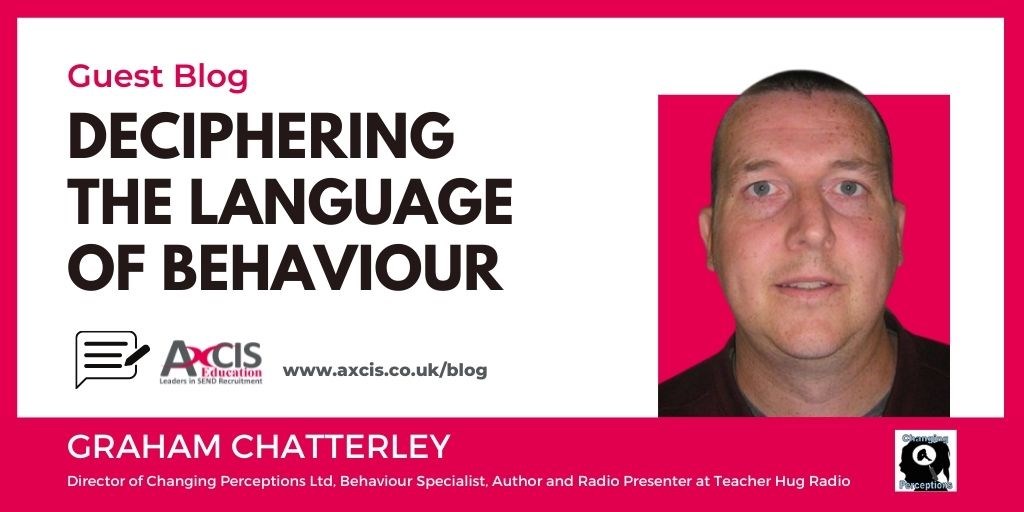Deciphering the Language of Behaviour

Guest blogger Graham Chatterely, regularly shares tips as educations resources in our Axcis blog. As a former senior leader of a specialist SEMH provision, Author, Director of "Changing Perceptions Limited" and regular presenter on Teacher Hug radio, Graham has extensive knowledge in the sector. He is also a dedicated father and two of his children have additional SEND needs. His experience in school settings and understanding of challenges at home offer profound insight.
Deciphering the Language of Behaviour
During Christmas 2019 I left my job as Assistant Head at a school I love, with staff I loved and kids I loved, but a Headteacher I didn’t love. I think we can call it creative differences and there were many reasons I had to go but the day I decided for definite was when I was asked to accept that systems were more important than relationships. There isn’t a fiber of my being that believes that and despite my best efforts I wasn’t going to change any minds so I decided that it had become time for something new.
I have been providing outreach support for some time and have developed my own training. I therefore decided to set up my own company, rather than seek another leadership role. With the pressures of home and the school workload I had dropped out of the NPQH so I couldn’t progress in that respect.
The first thing I needed was a name…
What is it I wanted to achieve? I went through the different parts of the course and which were the most relevant. The whole premise of the training is the idea that if we can increase staff understanding of children’s challenging behaviour then we can change the way staff react in times of crisis. More empathy for the “why” of behaviour creates a different response to the “what”. Therefore, what I’m actually trying to do is change the way staff perceive behaviour. For example – a realisation that a child is being disruptive because they are scared of failing at the work – rather than because they fancy giving a personal attack that day – means a different reaction from the staff – which in turn helps to reduce conflict. This also has a positive knock-on effect for staff wellbeing.
Challenging Perceptions Limited was born.
Now I needed a name for my main course; it used to be called ‘Reworking the Conflict Spiral’. Based on the Team Teach conflict spiral, it looked at how experiences like trauma, failure etc impact on feelings like low self esteem, frustration and anger. This drives avoidant and aggressive behaviour and how we as staff react depends on whether we end up with conflict. We often use punitive measures due to the policies in place at most schools.
If we rework this so that the reactions are less punitive and more empathetic then we can change experiences. Instead of failure, negativity and believing that adults are scary and can’t be trusted, they can become; I can do this, I can be more positive, adults can be trusted and that I might be different but that’s OK. These children then feel safer, like they belong and have more self-worth. This leads to a child who is calmer and who can access strategies because they are regulated and can remember them. We end up with no conflict because they can self-regulate.
Unfortunately, as I designed this course while in post at school, it officially “belongs” to them and as such I have been unable to bring it with me to my new venture and I was advised to design a new course. So that’s what I did – it was following an incident at school and a LinkedIn post that resulted. The post read;
- “I had a pupil make quite a significant disclosure today. Something that had been weighing on him for weeks.”
- “How did he tell me he wanted to disclose this?”
- “He tried to abscond, damaged displays, stabbed me with a screw, messed with my phone and stole my keys. When I didn’t hold him, send him home, fight with him for the equipment or threaten him with a consequence he came into another room and explained everything.”
Behaviour is a language and we all speak it if we take the time to decipher it!


Now usually the only time one of my LinkedIn posts is viewed a lot is if it’s a video of Daniel (my disabled genius slash spawn of Satan son) and I’m cool with that, he’s far more interesting than I am. However this one seemed to strike a chord and I had loads of comments and lots of questions about it. When I had put the final sentence on I hadn’t thought much of it. I was doing my job, it’s a position I’ve been in before, something about his body language didn’t make me feel threatened and if it did escalate I knew I had the skills to manage it. That child needed to know I wouldn’t be pushed away and I wouldn’t reject him – and when he felt like he could trust me – he offloaded.
That’s the thing with our most challenging pupils. They are bottling up all sorts of emotions and don’t feel safe enough or trust anyone enough to share them. Eventually it overflows and we often see extreme behaviours as a result. We have to do our best to take a step back and we have to look behind the behaviour.
So I decided to call my course ‘Deciphering the Language of Behaviour’ and that’s what I am trying to help people do. It’s the same principal with a lot of the same content as my previous course and raising understanding and empathy is still the focus. We have to pass some tests to prove we are worthy enough to earn their trust. You may be the only adult in their life who has ever been trusted and that is a very special thing.
If you'd like to learn from Graham and his work then don't hesitate to check out his book Building Positive Behaviour: Returning to learning using a Sequential Approach which is available for purchase on amazon or follow him on twitter @grahamchatterl2 .
